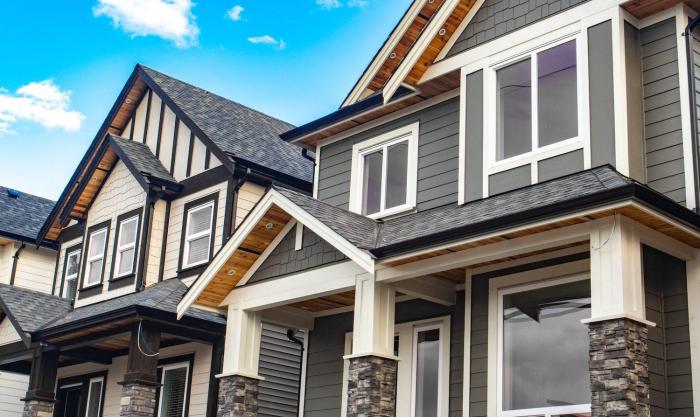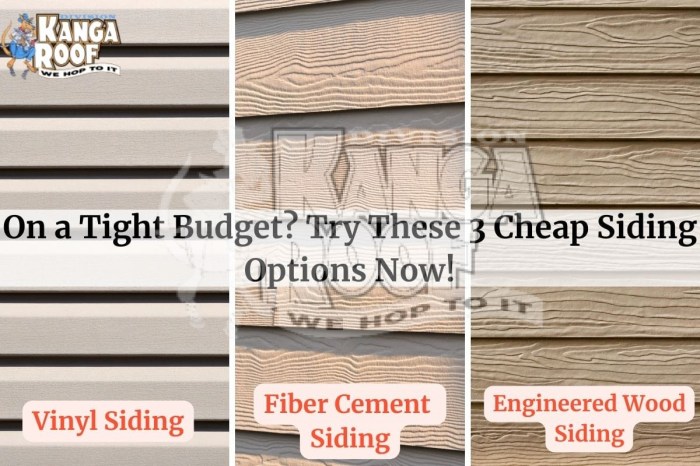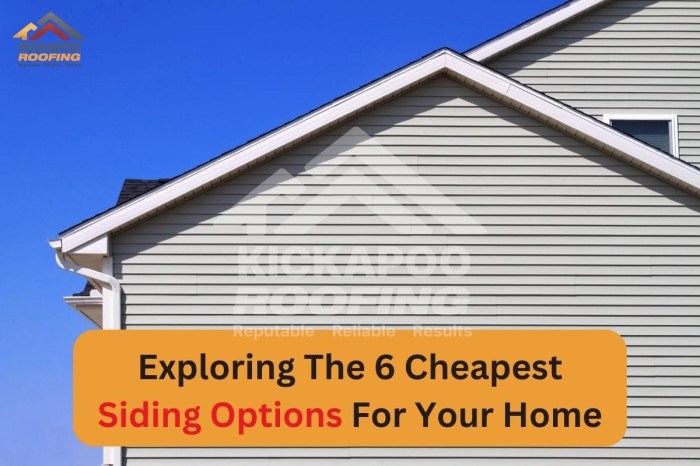Exploring Affordable Home Siding Options: A Comprehensive Guide
Delving into the world of affordable home siding options, this guide offers a detailed look at different materials, costs, and considerations, providing valuable insights for homeowners seeking to enhance their property.
Types of Affordable Home Siding Options

When it comes to affordable home siding options, there are several materials to choose from that offer a balance between cost-effectiveness, durability, and maintenance requirements.
Vinyl Siding
- Vinyl siding is one of the most cost-effective options available.
- It is low maintenance and comes in a variety of colors and styles.
- While durable, it may not withstand extreme weather conditions as well as other materials.
Wood Siding
- Wood siding provides a natural and classic look to a home.
- It is relatively affordable, but maintenance is required to prevent rot and insect damage.
- While durable, wood siding may require more upkeep compared to other materials.
Metal Siding
- Metal siding is known for its longevity and resistance to fire, rot, and insects.
- It is cost-effective and requires minimal maintenance over time.
- However, metal siding may dent or scratch more easily than other materials.
Fiber Cement Siding
- Fiber cement siding offers a balance of affordability and durability.
- It is resistant to rot, insects, and fire, making it a low-maintenance option.
- While the initial cost may be higher than vinyl or wood, fiber cement siding is known for its long lifespan.
Factors to Consider When Choosing Affordable Siding

When selecting affordable siding options for your home, it is essential to consider various factors to ensure you make the best choice. Factors such as cost, longevity, aesthetics, and energy efficiency play a crucial role in determining the most suitable siding for your property.
Additionally, factors like climate and location can significantly impact your siding choices. It is also important to weigh the installation costs against long-term savings to make an informed decision.
Cost
- Consider the upfront cost of the siding material, including installation expenses.
- Look for affordable options that provide good value for money without compromising quality.
- Compare prices of different siding materials to find the most cost-effective solution for your budget.
Longevity
- Choose siding materials that are durable and can withstand the elements over an extended period.
- Consider the maintenance requirements of the siding to ensure it will last for many years.
- Opt for materials with a long lifespan to avoid frequent replacements and additional costs in the future.
Aesthetics
- Select siding options that enhance the curb appeal of your home and complement its architectural style.
- Choose colors and textures that appeal to your personal taste and create a cohesive look for your property.
- Ensure the siding material you choose adds value to your home and increases its overall aesthetic appeal.
Energy Efficiency
- Consider siding materials that offer insulation properties to improve the energy efficiency of your home.
- Look for options that can help regulate indoor temperature and reduce heating and cooling costs.
- Choose eco-friendly siding materials that contribute to a greener and more sustainable living environment.
Pros and Cons of Popular Affordable Siding Materials

Vinyl, wood, and fiber cement are commonly used affordable siding materials for homes. Each material has its own set of advantages and disadvantages that homeowners should consider before making a choice.
Overview of Vinyl Siding
Vinyl siding is a popular choice for its affordability and low maintenance requirements. It is available in a wide range of colors and styles, making it versatile for different home designs. However, vinyl siding may crack or fade over time, and it is not as durable as some other materials.
Pros and Cons of Wood Siding
Wood siding offers a natural and timeless look that many homeowners appreciate. It can be more expensive upfront compared to vinyl, but it can add value to a home. However, wood siding requires regular maintenance, such as painting or staining, to prevent rot and insect damage, which can add to the overall cost over time.
Durability and Energy Efficiency of Fiber Cement Siding
Fiber cement siding is known for its durability and resistance to rot, fire, and insects. It is also energy efficient, helping to insulate homes and reduce energy costs. However, fiber cement siding can be heavier and more difficult to install than other materials, which may increase labor costs during installation.
Eco-Friendly and Recycled Siding Options
When it comes to choosing siding for your home, considering eco-friendly and recycled options can help reduce your carbon footprint and contribute to a more sustainable environment. These siding materials are not only environmentally friendly but also offer durability and aesthetic appeal for your home.
Recycled Wood Siding
Recycled wood siding is a popular choice for eco-conscious homeowners. This siding material is made from reclaimed wood from old barns, fences, or pallets, giving a rustic and unique look to your home. By opting for recycled wood siding, you are helping reduce deforestation and waste while adding character to your property.
Composite Siding
Composite siding is another eco-friendly option that is made from a combination of recycled wood fibers, plastics, and other materials. This siding material mimics the look of natural wood but requires less maintenance and is more durable. Composite siding is resistant to rot, insects, and moisture, making it a sustainable choice for your home exterior.
Environmental Impact of Different Siding Choices
When choosing siding materials, it is essential to consider the environmental impact of each option. Traditional siding materials like vinyl or aluminum can have a detrimental effect on the environment due to their manufacturing process and disposal. On the other hand, eco-friendly siding options like recycled wood and composite siding help reduce waste and promote sustainability.
Benefits of Using Eco-Friendly Siding Options
Opting for eco-friendly siding options not only benefits the environment but also offers several advantages for homeowners. These benefits include improved energy efficiency, reduced maintenance costs, enhanced curb appeal, and increased property value. By choosing sustainable siding materials, you can enjoy a beautiful and eco-conscious home exterior for years to come.
Last Word
In conclusion, the realm of affordable home siding options presents a myriad of choices, each with its own set of benefits and drawbacks. By weighing factors like cost, durability, and eco-friendliness, homeowners can make informed decisions to revamp their exteriors effectively.
Q&A
Is vinyl siding a cost-effective option?
Yes, vinyl siding is known for its affordability and low maintenance requirements, making it a popular choice among homeowners.
How does climate influence siding choices?
Climate plays a crucial role in selecting siding materials, as factors like temperature fluctuations and moisture levels can impact the durability and performance of the siding.
Are eco-friendly siding options sustainable in the long run?
Yes, opting for eco-friendly siding materials like recycled wood or composite siding not only reduces environmental impact but also ensures long-term sustainability for your home.




